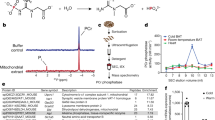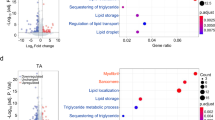Abstract
The role of skeletal muscle in nonshivering thermogenesis (NST) is not well understood. Here we show that sarcolipin (Sln), a newly identified regulator of the sarco/endoplasmic reticulum Ca2+-ATPase (Serca) pump1,2,3,4,5, is necessary for muscle-based thermogenesis. When challenged to acute cold (4 °C), Sln−/− mice were not able to maintain their core body temperature (37 °C) and developed hypothermia. Surgical ablation of brown adipose tissue and functional knockdown of Ucp1 allowed us to highlight the role of muscle in NST. Overexpression of Sln in the Sln-null background fully restored muscle-based thermogenesis, suggesting that Sln is the basis for Serca-mediated heat production. We show that ryanodine receptor 1 (Ryr1)-mediated Ca2+ leak is an important mechanism for Serca-activated heat generation. Here we present data to suggest that Sln can continue to interact with Serca in the presence of Ca2+, which can promote uncoupling of the Serca pump and cause futile cycling. We further show that loss of Sln predisposes mice to diet-induced obesity, which suggests that Sln-mediated NST is recruited during metabolic overload. These data collectively suggest that SLN is an important mediator of muscle thermogenesis and whole-body energy metabolism.
This is a preview of subscription content, access via your institution
Access options
Subscribe to this journal
Receive 12 print issues and online access
$209.00 per year
only $17.42 per issue
Buy this article
- Purchase on Springer Link
- Instant access to full article PDF
Prices may be subject to local taxes which are calculated during checkout




Similar content being viewed by others
Change history
06 December 2012
The authors would like to add two co-authors, A. Russell Tupling and Eric Bombardier, to the study. The author list, Acknowledgments and Author Contributions have been corrected in the HTML and PDF versions of this article.
References
Asahi, M. et al. Cardiac-specific overexpression of sarcolipin inhibits sarco(endo)plasmic reticulum Ca2+ ATPase (SERCA2a) activity and impairs cardiac function in mice. Proc. Natl. Acad. Sci. USA 101, 9199–9204 (2004).
Asahi, M. et al. Sarcolipin regulates sarco(endo)plasmic reticulum Ca2+-ATPase (SERCA) by binding to transmembrane helices alone or in association with phospholamban. Proc. Natl. Acad. Sci. USA 100, 5040–5045 (2003).
Babu, G.J. et al. Targeted overexpression of sarcolipin in the mouse heart decreases sarcoplasmic reticulum calcium transport and cardiac contractility. J. Biol. Chem. 281, 3972–3979 (2006).
Babu, G.J. et al. Ablation of sarcolipin enhances sarcoplasmic reticulum calcium transport and atrial contractility. Proc. Natl. Acad. Sci. USA 104, 17867–17872 (2007).
Babu, G.J. et al. Overexpression of sarcolipin decreases myocyte contractility and calcium transient. Cardiovasc. Res. 65, 177–186 (2005).
Block, B.A. Thermogenesis in muscle. Annu. Rev. Physiol. 56, 535–577 (1994).
Silva, J.E. Physiological importance and control of non-shivering facultative thermogenesis. Front. Biosci. (Schol. Ed.) 3, 352–371 (2011).
Enerbäck, S. et al. Mice lacking mitochondrial uncoupling protein are cold-sensitive but not obese. Nature 387, 90–94 (1997).
Dawkins, M.J. & Scopes, J.W. Non-shivering thermogenesis and brown adipose tissue in the human new-born infant. Nature 206, 201–202 (1965).
Cannon, B. & Nedergaard, J. Metabolic consequences of the presence or absence of the thermogenic capacity of brown adipose tissue in mice (and probably in humans). Int. J. Obes. (Lond.) 34 (suppl. 1), S7–S16 (2010).
Kjelstrup, S., Barragan, D. & Bedeaux, D. Coefficients for active transport and thermogenesis of Ca2+-ATPase isoforms. Biophys. J. 96, 4376–4386 (2009).
Anunciado-Koza, R.P. et al. Inactivation of the mitochondrial carrier SLC25A25 (ATP-Mg2+/Pi transporter) reduces physical endurance and metabolic efficiency in mice. J. Biol. Chem. 286, 11659–11671 (2011).
Block, B.A. & Franzini-Armstrong, C. The structure of the membrane systems in a novel muscle cell modified for heat production. J. Cell Biol. 107, 1099–1112 (1988).
Block, B.A., O'Brien, J. & Meissner, G. Characterization of the sarcoplasmic reticulum proteins in the thermogenic muscles of fish. J. Cell Biol. 127, 1275–1287 (1994).
Morrissette, J.M., Franck, J.P. & Block, B.A. Characterization of ryanodine receptor and Ca2+-ATPase isoforms in the thermogenic heater organ of blue marlin (Makaira nigricans). J. Exp. Biol. 206, 805–812 (2003).
da Costa, D.C. & Landeira-Fernandez, A.M. Thermogenic activity of the Ca2+-ATPase from blue marlin heater organ: regulation by KCl and temperature. Am. J. Physiol. Regul. Integr. Comp. Physiol. 297, R1460–R1468 (2009).
MacLennan, D.H. Ca2+ signalling and muscle disease. Eur. J. Biochem. 267, 5291–5297 (2000).
Smith, W.S., Broadbridge, R., East, J.M. & Lee, A.G. Sarcolipin uncouples hydrolysis of ATP from accumulation of Ca2+ by the Ca2+-ATPase of skeletal-muscle sarcoplasmic reticulum. Biochem. J. 361, 277–286 (2002).
Mall, S. et al. The presence of sarcolipin results in increased heat production by Ca2+-ATPase. J. Biol. Chem. 281, 36597–36602 (2006).
Tupling, A.R. et al. Enhanced Ca2+ transport and muscle relaxation in skeletal muscle from sarcolipin-null mice. Am. J. Physiol. Cell Physiol. 301, C841–C849 (2011).
Hofmann, W.E., Liu, X., Bearden, C.M., Harper, M.E. & Kozak, L.P. Effects of genetic background on thermoregulation and fatty acid–induced uncoupling of mitochondria in UCP1-deficient mice. J. Biol. Chem. 276, 12460–12465 (2001).
Vitali, A. et al. The adipose organ of obesity-prone C57BL/6J mice is composed of mixed white and brown adipocytes. J. Lipid Res. 53, 619–629 (2012).
Lim, S. et al. Cold-induced activation of brown adipose tissue and adipose angiogenesis in mice. Nat. Protoc. 7, 606–615 (2012).
Kashimura, O., Sakai, A., Yanagidaira, Y. & Ueda, G. Thermogenesis induced by inhibition of shivering during cold exposure in exercise-trained rats. Aviat. Space Environ. Med. 63, 1082–1086 (1992).
Bowman, W.C. Neuromuscular block. Br. J. Pharmacol. 147 (suppl. 1), S277–S286 (2006).
Wang, R. et al. Localization of the dantrolene-binding sequence near the FK506-binding protein-binding site in the three-dimensional structure of the ryanodine receptor. J. Biol. Chem. 286, 12202–12212 (2011).
Kjelstrup, S., de Meis, L., Bedeaux, D. & Simon, J.M. Is the Ca2+-ATPase from sarcoplasmic reticulum also a heat pump? Eur. Biophys. J. 38, 59–67 (2008).
de Meis, L., Arruda, A.P. & Carvalho, D.P. Role of sarco/endoplasmic reticulum Ca2+-ATPase in thermogenesis. Biosci. Rep. 25, 181–190 (2005).
Jones, L.R., Cornea, R.L. & Chen, Z. Close proximity between residue 30 of phospholamban and cysteine 318 of the cardiac Ca2+ pump revealed by intermolecular thiol cross-linking. J. Biol. Chem. 277, 28319–28329 (2002).
Rippe, C., Berger, K., Boiers, C., Ricquier, D. & Erlanson-Albertsson, C. Effect of high-fat diet, surrounding temperature, and enterostatin on uncoupling protein gene expression. Am. J. Physiol. Endocrinol. Metab. 279, E293–E300 (2000).
Arruda, A.P. et al. Cold tolerance in hypothyroid rabbits: role of skeletal muscle mitochondria and sarcoplasmic reticulum Ca2+ ATPase isoform 1 heat production. Endocrinology 149, 6262–6271 (2008).
Bicudo, J.E., Vianna, C.R. & Chaui-Berlinck, J.G. Thermogenesis in birds. Biosci. Rep. 21, 181–188 (2001).
Berg, F., Gustafson, U. & Andersson, L. The uncoupling protein 1 gene (UCP1) is disrupted in the pig lineage: a genetic explanation for poor thermoregulation in piglets. PLoS Genet. 2, e129 (2006).
Babu, G.J., Bhupathy, P., Carnes, C.A., Billman, G.E. & Periasamy, M. Differential expression of sarcolipin protein during muscle development and cardiac pathophysiology. J. Mol. Cell. Cardiol. 43, 215–222 (2007).
Cypess, A.M. et al. Identification and importance of brown adipose tissue in adult humans. N. Engl. J. Med. 360, 1509–1517 (2009).
Babu, G.J. et al. Ablation of sarcolipin enhances sarcoplasmic reticulum calcium transport and atrial contractility. Proc. Natl. Acad. Sci. USA 104, 17867–17872 (2007).
Brennan, K.J. & Hardeman, E.C. Quantitative analysis of the human α-skeletal actin gene in transgenic mice. J. Biol. Chem. 268, 719–725 (1993).
Kashimura, O., Sakai, A., Yanagidaira, Y. & Ueda, G. Thermogenesis induced by inhibition of shivering during cold exposure in exercise-trained rats. Aviat. Space Environ. Med. 63, 1082–1086 (1992).
Dainese, M. et al. Anesthetic- and heat-induced sudden death in calsequestrin-1–knockout mice. FASEB J. 23, 1710–1720 (2009).
Jones, L.R., Cornea, R.L. & Chen, Z. Close proximity between residue 30 of phospholamban and cysteine 318 of the cardiac Ca2+ pump revealed by intermolecular thiol cross-linking. J. Biol. Chem. 277, 28319–28329 (2002).
Maruyama, K. & MacLennan, D.H. Mutation of aspartic acid-351, lysine-352, and lysine-515 alters the Ca2+ transport activity of the Ca2+-ATPase expressed in COS-1 cells. Proc. Natl. Acad. Sci. USA 85, 3314–3318 (1988).
Acknowledgements
This work was supported in part by US National Institutes of Health grant R01 (HL080551) to M. Periasamy. N.C.B. was supported by a postdoctoral fellowship from the American Physiological Society and the American Heart Association (10POST3360007). This work was also supported in part by research grants from the Canadian Institutes of Health Research to A.R.T. (MOP 86618 and MOP 47296). We thank P. Mohler, J.A. Rafael-Fortney and J.E. Ostler, for comments on the manuscript. We thank N. Manivannan and K. Powell (Ohio State University Medical Center, Davis Heart and Lung Research Institute, Small Animal Imaging Facility, Columbus, Ohio, USA) for MRI of mice.
Author information
Authors and Affiliations
Contributions
M. Periasamy and N.C.B. conceived of the study idea and designed the experiments. D.H.S., S.A.S., M. Pant and L.A.R. designed and conducted mouse breeding. S.K.M., N.C.B., D.H.S. and M. Pant performed the thermogenesis experiments. N.C.B., S.C.G. and S.K.M. conducted HFD feeding experiments. S.K.S. designed and conducted chemical crosslinking studies. E.B. designed and conducted HFD experiments on Sln–/– mice. A.R.T. conceived the idea of and designed the HFD studies. S.A.G. and J.D.M. generated and characterized the Sln overexpression mouse model. M. Periasamy, S.K.M., S.K.S., N.C.B. and D.H.S. analyzed the data and assembled the figures. M. Periasamy, N.C.B. and D.H.S. wrote the manuscript.
Corresponding author
Ethics declarations
Competing interests
The authors declare no competing financial interests.
Supplementary information
Supplementary Text and Figures
Supplementary Figures 1–5 (PDF 575 kb)
Supplementary Video 1
Shivering is not impaired in Sln−/− mice. (MP4 12606 kb)
Supplementary Video 2
Curare treatment minimizes shivering. (MP4 13584 kb)
Rights and permissions
About this article
Cite this article
Bal, N., Maurya, S., Sopariwala, D. et al. Sarcolipin is a newly identified regulator of muscle-based thermogenesis in mammals. Nat Med 18, 1575–1579 (2012). https://doi.org/10.1038/nm.2897
Received:
Accepted:
Published:
Issue Date:
DOI: https://doi.org/10.1038/nm.2897
This article is cited by
-
mTORC1 in energy expenditure: consequences for obesity
Nature Reviews Endocrinology (2024)
-
Pre-hibernation diet alters skeletal muscle relaxation kinetics, but not force development in torpid arctic ground squirrels
Journal of Comparative Physiology B (2024)
-
Cold exposure alters lipid metabolism of skeletal muscle through HIF-1α-induced mitophagy
BMC Biology (2023)
-
Physiological and molecular mechanisms of cold-induced improvements in glucose homeostasis in humans beyond brown adipose tissue
International Journal of Obesity (2023)
-
Reproductive Functions of the Mitochondrial Progesterone Receptor (PR-M)
Reproductive Sciences (2023)



